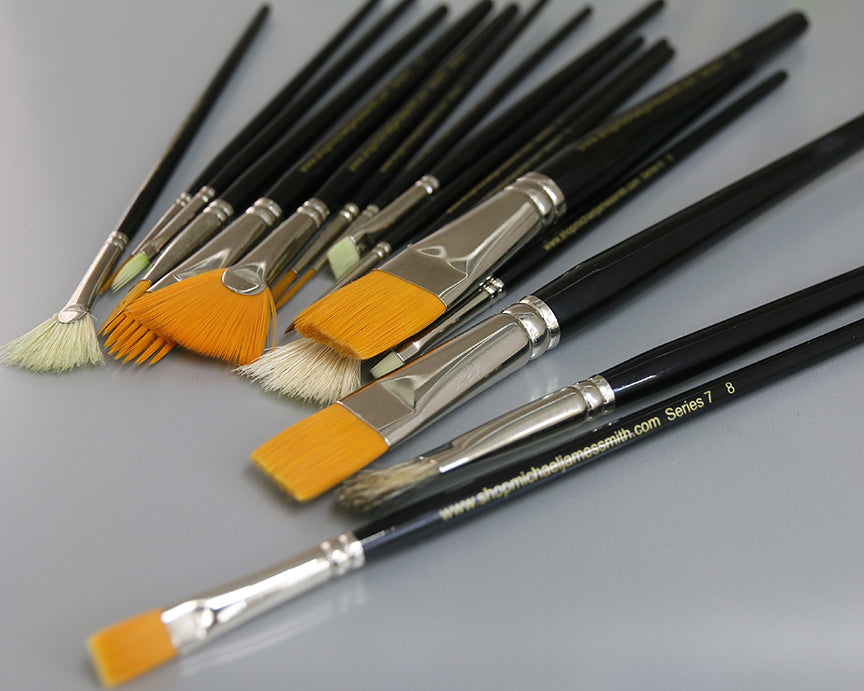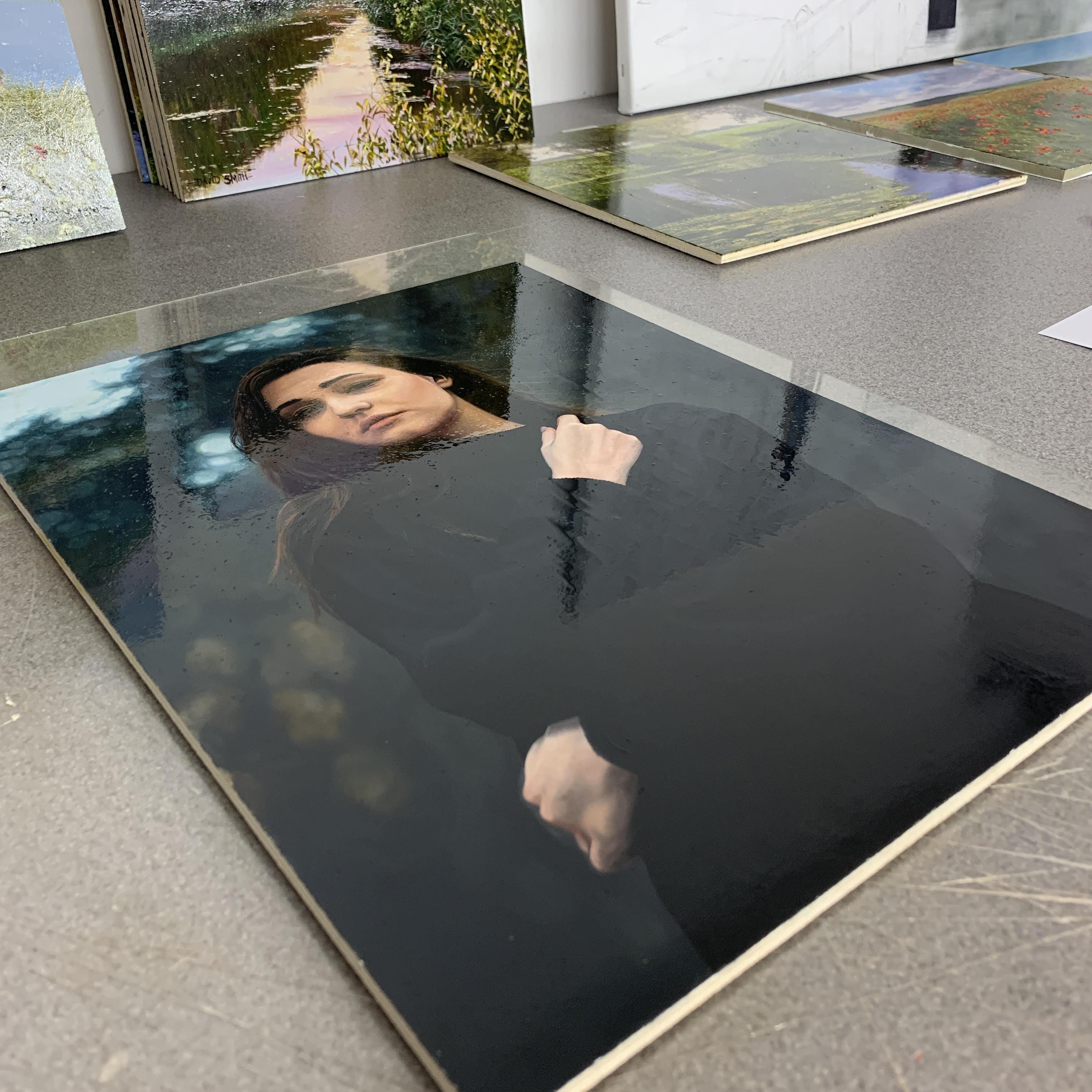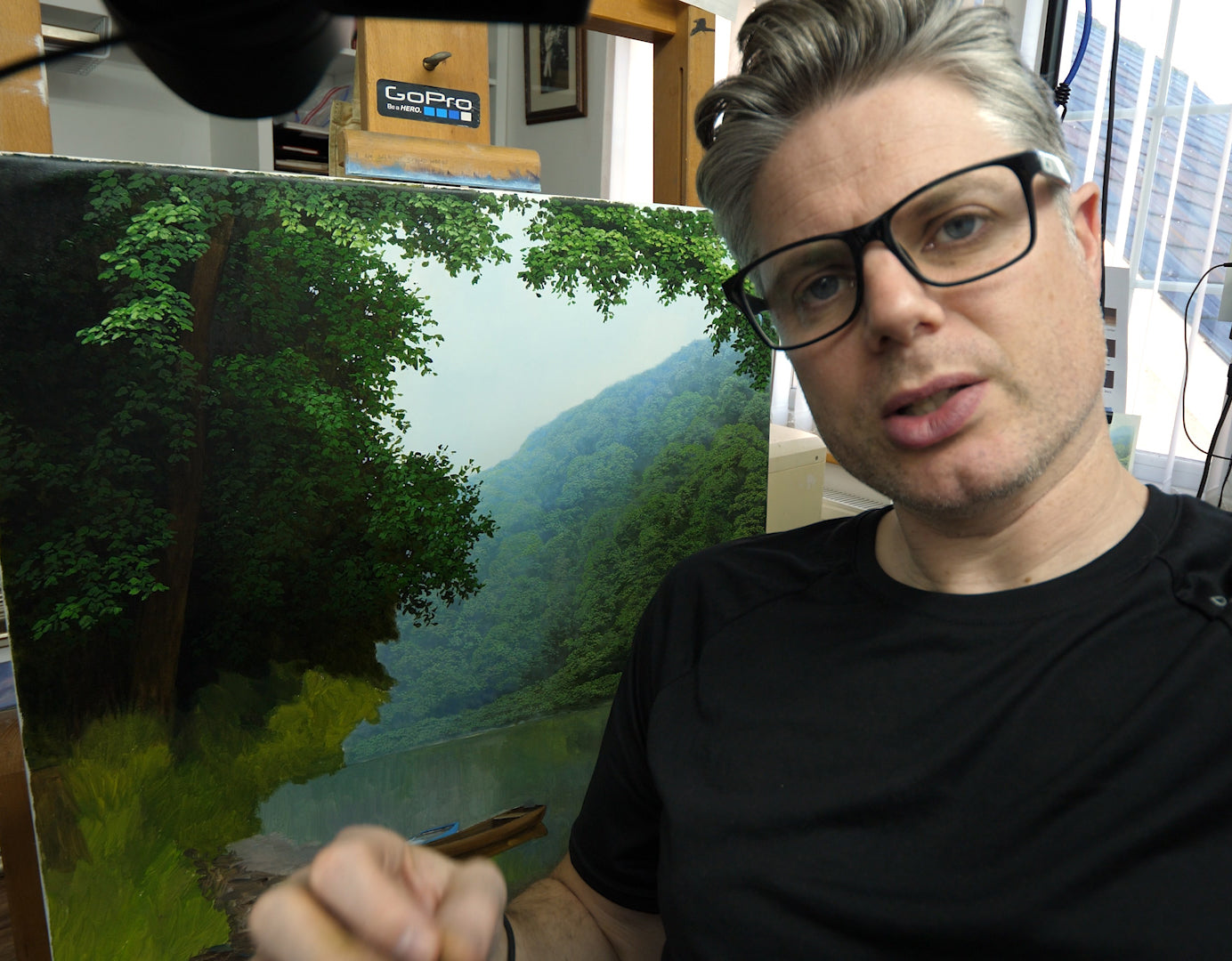
Frequently Asked Questions | Equipment
What is the difference between oil painting on panels and canvas?
The technique I have developed over the many years I have been painting can be done either on a smooth canvas or a smooth panel. When I paint on canvas I typically purchase one that is of smooth portrait quality. MJS Artists Exhibition Panels are my preferred surface choice, as they are ready to paint onto straight out of the packaging. My technique is best when painted on a smooth surface, so it is necessary to prepare canvas surfaces to be as smooth as possible for the same results that my smooth Artists Exhibition Panels provide. My technique is the same when I paint on a larger or smaller panel, but I prefer the smaller panels because of the level of detail I can achieve.
What lighting should I use when oil painting?
I use 5000K white light bulbs which are considered a “natural light”. If you are unable to find suitable bulbs in your area www.1000Bulbs.com has Spiral CFL 5000K Full Spectrum bulbs. The equal to 100W or 60W can be used.
What advice do you have for oil painting on canvas?
I prefer a very smooth surface for the detailed paintings I do. When I have painted on canvas, I purchased the smoother weave canvas that was portrait quality. Either cotton or linen canvas will work equally well for this technique. I tend to use different sizes for my paintings believing that some paintings are best in a square format while others appear best in a rectangular one. However, I use my own Artists Exhibition Panels which are great because they do not require any preparation before use.
What paint brushes do you use?
I have a collection of brushes from my online store. If you're just starting out, I recommend purchasing the Michael James Smith Professional Brush Set. This set contains the combination of both soft and stiff, flat and round, long and short brushes I use. In my lessons, I demonstrate the use of all these brushes to help you understand what each brush is best used for. The same brush can achieve many different effects depending on how it is used.
What are you using to display the photos you paint from?
I’m using a Samsung tablet with a 10 1/2″ screen. The majority of tablets now have exceptional screen resolution, giving crisp and accurate colours, and best of all you can zoom into your reference photo as needed.
What colours do you use for your oil paintings?
I provide a complete list of all the normal colours I use in my lessons on the website, please see here. I normally use these same colours for every subject I paint and rarely ever add a “special” colour. When I need different colours, such as varying the shade of greens for a tree canopy or grass, I add different colours to the mix until I have the different shades. I use darker transparent colours for the shadow area, more saturated or less saturated (meaning grayed or purer colour) as the second and third layers, and lighten the greens with yellow to keep the saturation (purer colour) first, and only add white at the very last stage when, perhaps, I need better covering power. It is an advantage to have 3-6 different colours to help achieve the 3D effect of trees or grasses. In my online lessons, I give detailed instructions on how I mix my colours and also name them as I proceed and give reasons for the additions. If you need a very basic list of colours to use I would suggest Titanium White, Ivory Black, Sap Green, Burnt Umber, Windsor Lemon, Cadmium Yellow Light, Cerulean Blue, and Alazarin Crimson.
Why do you use oil paint rather than acrylic?
I prefer the final appearance of oil paint because of its vibrancy, transparency and usability and I enjoy being able to blend and achieve the effects that I can. I have started using acrylic in my block-ins because they dry so fast, allowing me to quickly move right into the oils and details of my paintings.
What alternatives can I use instead of liquin?
Liquin was formulated by Winsor and Newton for use with their Alkyd Fast Drying Oil Paint but it has become very popular with artists who use oil paint regularly. The Liquin is designed to aid in the speed at which the paint dries and is excellent for use in glazing. After my acrylic block-in is dry, I very often use Liquin as a glaze over the block-in and then add my details on top of that depending on the subject I am painting. Any medium that is suitable for oil paint can be used for this technique. If linseed oil is used it will make the paint film dry slower.
What oil paint do you use?
I previously used Winsor and Newton Alkyd Fast Drying Oil Colours, however I’m currently using my own brand of oil paints which will be available in store soon.
Any artist grade (not student grade) oil paint should be fine though. Student grade paint contains more filler so you will not get the same results as artist quality paint. I have tried water mixable oil paints but felt they did not mix well with water. Also, I do not use the colour black. The black often used in my glazes is mixed with other colours like Sap Green. When I use black in other mixes it is a very small amount and is used to bring down the saturation (purity) of the colour. Green can also be created by mixing black with yellow to create an olive type green which can be used successfully for landscapes. The colours I use for most of my paintings can be found here. I rarely ever use any other colour than the ones listed, no matter what the subject is that I am working on.
What paint brushes do you use to create different effects?
Over the years I have used some of my worn brushes to create different effects, but to help students I have created a specific group of brushes, so that when I demonstrate one of my techniques the students can have the same brush. This group of brushes can be found on my store website, please see here. Within my online lessons, I demonstrate the use of each of these brushes. For instance, I often use the short white ivory brush to achieve foliage, while a tree and texture brush can be used to add a glaze to an acrylic base in preparation for the details to be applied on top of that in oils. I often use the rigger brush for individual blades of grass or leaves on trees. The same brushes can be used for many different effects in the paintings.
What alternatives can I use instead of turpentine?
Windsor and Newton has a low-odour option for use with oil paints, “Winsor and Newton Sansodor”. A low-odour solvent to clean your brushes can also be found in Windsor and Newton Brush Cleaner. Should the odour be an issue there are some helpful tips on the Winsor and Newton website.
What do you use white spirit for?
I use white spirit to clean my paint brushes, as well as to thin my paint for when I am applying the paint in the later layers of the painting. Paint that has been thinned with white spirit creates sharper edges, which is helpful in the foreground areas. This thinned paint will also allow me to add new paint on top of a wet (or slightly tacky) undercoat without disturbing It. For example, when you want to add highlights like grass or foliage to a glaze of darker paint. The one drawback is that by thinning the paint you lose vibrancy density and coverage.
Do you use the same brush for alkyds and oils?
Yes, the same brushes can be used for both types of oil paint – alkyd oil paint and regular oil paint.
How long do your paint brushes last?
Typically my frequently used paint brushes are replaced every two to three weeks, but this depends on how often I paint with these brushes and how well I look after them (not as well as I should). I do not use all my brushes as often as I do others. I tend to replace riggers (series 1) when I find they are not providing the sharp edge that I need for some of my paintings. A set of my brushes that are cleaned properly should last up to six months.
How do you clean your paint brushes?
I clean my paint brushes in white spirit by swishing them briskly and wiping on a clean paper towel until no paint or colour can be seen. This should be all that is needed to keep your brushes clean.
How do you age your paint brushes?
At times it is to my advantage to have slightly “aged” brushes. I can rub them on sandpaper, concrete, or other slightly rough surfaces to create this aged effect. The pressure used will determine the extent of the damage caused to the brush. Not cleaning brushes well can also create a slightly aged brush as the paint will harden near the base of the brush, providing you with the perfect brush for some effects. You can also trim a few small cuts into the end of a brush to cause a jagged edge.
Do you trim your paint brushes?
Yes, I do occasionally trim my used paint brushes. You can watch me demonstrating how I do this in my ‘How to Paint Conifers’ on YouTube.
Here, you will see me sharpening a used flat brush to re-establish the squared off edge for better foliage “v” strokes. I use an exacto knife but any other very sharp edge like a razor blade could work as well.
Do I need to buy both alkyd and acrylic colours?
No, you don’t need to buy both as my technique can be achieved using regular oil paints. Both the block-in and the painting can be completed using regular oil paint. I use acrylic for the block-in and alkyd fast drying oil paints to speed up the process of drying so that I can finish a painting quickly.
Do you have any tips for caring for your paint brushes?
Because I use Winsor and Newton Alkyd Fast Drying Paints, Liquin and white spirits, I usually clean any brush that I am not currently painting with. All of those products promote fast drying and I would not want the paint to dry in the brush. So, you will often notice that I mention cleaning the brush by swishing in white spirits. At the end of a day’s painting, I will always swish my paintbrushes in white spirits and wipe on a paper towel until no colour can be seen.
Can I use water mixable oil paints for your technique?
Yes, you can use water mixable oils. Winsor and Newton water mixable oil paints are good quality. Personally, I do not enjoy working with water mixable oil paints, as I found that they do not mix well with water. I prefer Winsor and Newton Alkyd Fast Drying Paints that I use now.

